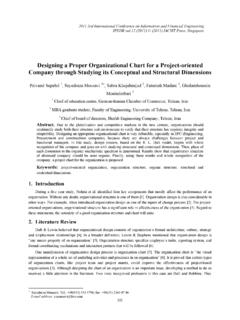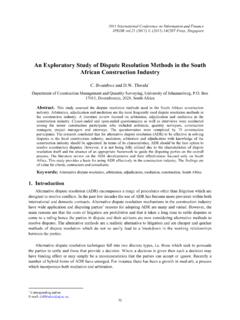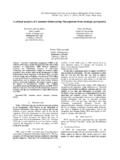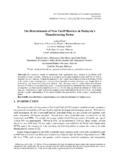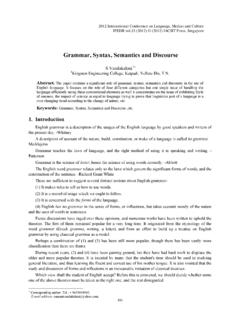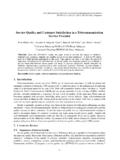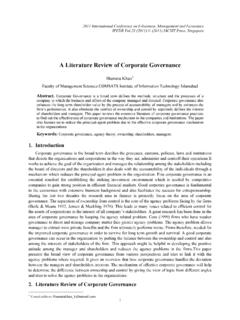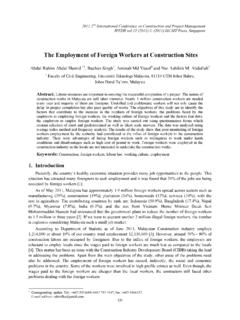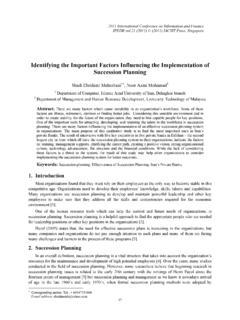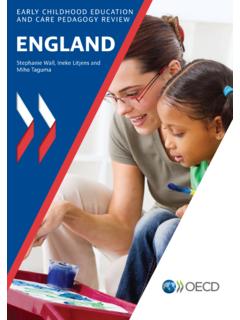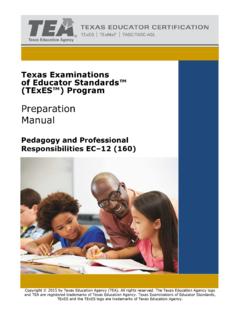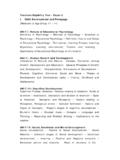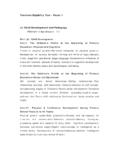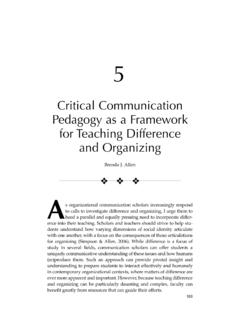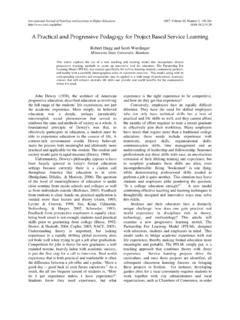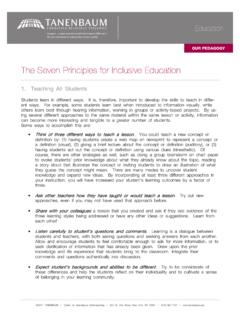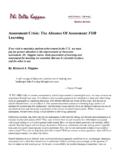Transcription of Basic Principles of Critical Pedagogy
1 Basic Principles of Critical Pedagogy Mohammad Aliakbari1 and Elham Faraji Ilam University-Iran Abstract. This article is intended to give some context to the discussion of Critical Pedagogy (CP) as one of the post method approaches to language teaching. It adopts the Frankfurt school Principles as its main source in search for a more just society. It relates the school context to the social context in which it is embedded. It stresses empowering learners to think and act critically with the aim of transforming their life conditions. Although this approach has recently gained momentum, few studies have exclusively addressed it. Therefore, the present study aims at exploring major themes in CP including the libratory and problem posing education, teacher and student roles, praxis as the reflection on the world, and dialogism and to make suggestions for application of this approach in ELT classrooms.
2 To achieve this aim, available books and articles written on the subject were scrutinized. The results showed that the transformative CP, despite being a new and useful approach, is barely explored and attended to in Iranian educational system. Key words: Critical Pedagogy , post method approach, Critical theory, history of language teaching, political education, praxis. 1. Introduction Critical Pedagogy (CP) is an approach to language teaching and learning which, according to Kincheloe (2005), is concerned with transforming relations of power which are oppressive and which lead to the oppression of people. It tries to humanize and empower learners. It is most associated with the Brazilian educator and activist Paulo Freire using the principals of Critical theory of the Frankfurt school as its main source. The prominent members of this Critical theory are Adorno, Marcuse, and Habermas.
3 Critical theory is concerned with the idea of a just society in which people have political, economic, and cultural control of their lives. Thinkers of Critical theory believe that these goals are satisfied only through emancipating oppressed people which empowers them and enables them to transform their life conditions. It is actually the starting point for Critical Pedagogy . The major concern of CP is with criticizing the schooling in capitalist societies. As Gor (2005) puts it, the major goals of CP are awareness raising and rejection of violation and discrimination against people. CP of Freire like Critical theory tries to transform oppressed people and to save them from being objects of education to subjects of their own autonomy and emancipation. In this view, students should act in a way that enables them to transform their societies which is best achieved through emancipatory education.
4 Through problem posing education and questioning the problematic issues in learners lives, students learn to think critically and develop a Critical consciousness which help them to improve their life conditions and to take necessary actions to build a more just and equitable society. Thus, it can be said that CP challenges any form of domination, oppression and subordination with the goal of emancipating oppressed or marginalized people. As Kessing-Styles (2003) points out, CP is an educational response to inequalities and oppressive 1 + Corresponding author. Tel.: (+988412223399); fax: (+988412238528). E-mail address: 77 2011 2nd International Conference on Humanities, Historical and Social Sciences IPEDR (2011) (2011)IACSIT Press, Singapore power relations which exist in educational institutions.
5 Majore authors associated with CP include Paulo Freire, Wolfgang Klafki, Michale Apple, Peter McLaren, Ira Shor, and Henry Giroux. According to Hall (1995), language learning theory and teaching should focus on larger sociohistorical and political forces which reside in the social identities of people who use them. However, recent research on SLA, as Okazaki (2005) argued, has shown that classrooms are far removed from historical and social conditions. He also maintains that, as a consequence, researchers advocating examining sociohistorical and political aspects of language learning including, Benesch, 2001; Canagarajah, 1999, 2002; Morgan 1998; Norton, 1997; Norton and Toohey, 2004; Pennycook, 1999, 2001; Ramanathan, 2002, proposed an alternative approach- Critical Pedagogy - which they believed should be the heart of language teaching.
6 It seems that CP in recent years has gained momentum. Evidence also comes from the large amount of practice done in this area, a large body of texts that explore it and the creation of a doctoral degree in CP (Brookfield, 2005). Despite receiving so much attention both in the past and recent years, it seems that few studies have exclusively aimed at examining major themes in CP. Thus, the present study aims to shed more light on major themes in CP including, education, teacher and student roles, praxis, and language and dialogue in CP. 2. CP and the Educational Process The major goal of CP, as Vandrick (1994) claims, is to emancipate and educate all people regardless of their gender, class, race, etc. Gadotti (1994) also notes that Pedagogy is of major interest for Freire by which he seeks to change the structure of an oppressive society. Critical Pedagogy in Kanpol s (1998) terms rests on the belief that every citizen deserves an education which involves understanding the schooling structure by the teacher that would not permit education to ensue.
7 Freire (1970) distinguishes between banking education and problem posing education. In the traditional view of education, teachers are pillars of knowledge; they know everything and students know nothing. Teachers deposit knowledge in students and never ask them to question that knowledge. The teacher thinks, the students don t. The teacher chooses the content, students comply with it. Teacher is authority and students are obedient to authority. Students in this model are receivers of knowledge. They receive, memorize and repeat. They are not asked to relate this knowledge to the current problems and injustices in society with the aim of improving the society. Accordingly, they get a passive role in this view. Freire (1970) refers metaphorically to the traditional view of education as banking model of education because it is like depositing of money in a bank.
8 This model mirrors the structure of an oppressive society in which the oppressed and the oppressors are divided. It advocates fixation of reality. So it is a vehicle for continuing the political oppression and working against liberation or emancipation (Joldersma, 1999). This model is rejected because teachers should concern about society and to give human beings the opportunity to critically reflect and act on the position within society. Joldersma (1999) criticizes this model on the ground that here knowledge is too packaged, complete and objective and easily transferable into passive students and depicts the world as static and unchangeable. In this model, students believe that power, authority and activity are held by the teacher and students are viewed as objects rather than human. So in Joldersma s (1999) term, this model is dehumanizing because it creates oppressive passivity in students.
9 As an alternative to the banking model, Freire (1970) proposed a problem posing education which can lead to Critical consciousness. According to Joldersma (1999), good teaching or problem posing Pedagogy leads to the development of knowledge by the students themselves. Freire, in the 1960 , suggested that through a problem posing process literacy becomes immediately relevant and engaging by focusing on problematic issues in learners lives. Problem posing education, according to Freire (1970), involves uncovering of reality, striving for the emergence of consciousness and Critical intervention in reality. This consciousness allows students to take the necessary actions to improve their life conditions (Freire, 1970). It is based on the realities of learners and their life situations. It shows people that they have the right to ask questions.
10 In this process of problem posing, the teacher listens to students, then, he selects and brings known situations to students in codified forms, finally he asks a series of inductive questions regarding the discussion of the situation (Muhammad Kamarul Kabilan, 1999). Moreover, Nixon-Ponder (1995) maintains that, the learner undergoes five steps of problem posing respectively ; describing the content of discussion, defining the problem, personalizing the problem, discussing the problem, and discussing the alternatives of 78the problem. In different terms, Elias (1976) confirms that in problem posing model students are closely equal to their teachers regarding the problem under analysis and the developing knowledge. They exercise freedom and together with the teacher control the educational process.
